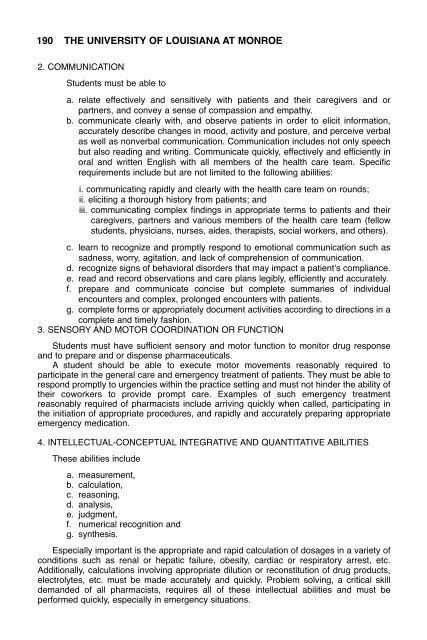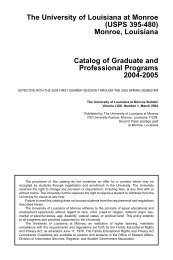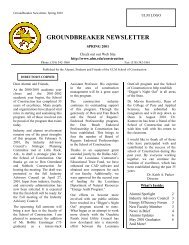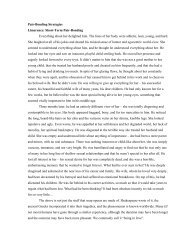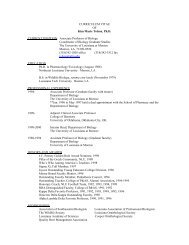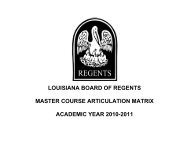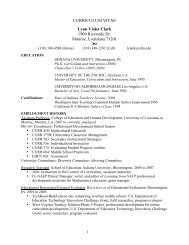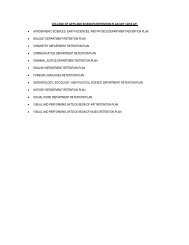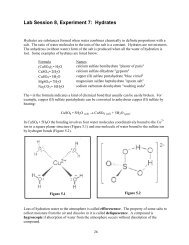08-09 Graduate Catalog/w pics - University of Louisiana at Monroe
08-09 Graduate Catalog/w pics - University of Louisiana at Monroe
08-09 Graduate Catalog/w pics - University of Louisiana at Monroe
You also want an ePaper? Increase the reach of your titles
YUMPU automatically turns print PDFs into web optimized ePapers that Google loves.
190 THE UNIVERSITY OF LOUISIANA AT MONROE<br />
2. COMMUNICATION<br />
Students must be able to<br />
a. rel<strong>at</strong>e effectively and sensitively with p<strong>at</strong>ients and their caregivers and or<br />
partners, and convey a sense <strong>of</strong> compassion and emp<strong>at</strong>hy.<br />
b. communic<strong>at</strong>e clearly with, and observe p<strong>at</strong>ients in order to elicit inform<strong>at</strong>ion,<br />
accur<strong>at</strong>ely describe changes in mood, activity and posture, and perceive verbal<br />
as well as nonverbal communic<strong>at</strong>ion. Communic<strong>at</strong>ion includes not only speech<br />
but also reading and writing. Communic<strong>at</strong>e quickly, effectively and efficiently in<br />
oral and written English with all members <strong>of</strong> the health care team. Specific<br />
requirements include but are not limited to the following abilities:<br />
i. communic<strong>at</strong>ing rapidly and clearly with the health care team on rounds;<br />
ii. eliciting a thorough history from p<strong>at</strong>ients; and<br />
iii. communic<strong>at</strong>ing complex findings in appropri<strong>at</strong>e terms to p<strong>at</strong>ients and their<br />
caregivers, partners and various members <strong>of</strong> the health care team (fellow<br />
students, physicians, nurses, aides, therapists, social workers, and others).<br />
c. learn to recognize and promptly respond to emotional communic<strong>at</strong>ion such as<br />
sadness, worry, agit<strong>at</strong>ion, and lack <strong>of</strong> comprehension <strong>of</strong> communic<strong>at</strong>ion.<br />
d. recognize signs <strong>of</strong> behavioral disorders th<strong>at</strong> may impact a p<strong>at</strong>ient’s compliance.<br />
e. read and record observ<strong>at</strong>ions and care plans legibly, efficiently and accur<strong>at</strong>ely.<br />
f. prepare and communic<strong>at</strong>e concise but complete summaries <strong>of</strong> individual<br />
encounters and complex, prolonged encounters with p<strong>at</strong>ients.<br />
g. complete forms or appropri<strong>at</strong>ely document activities according to directions in a<br />
complete and timely fashion.<br />
3. SENSORY AND MOTOR COORDINATION OR FUNCTION<br />
Students must have sufficient sensory and motor function to monitor drug response<br />
and to prepare and or dispense pharmaceuticals.<br />
A student should be able to execute motor movements reasonably required to<br />
particip<strong>at</strong>e in the general care and emergency tre<strong>at</strong>ment <strong>of</strong> p<strong>at</strong>ients. They must be able to<br />
respond promptly to urgencies within the practice setting and must not hinder the ability <strong>of</strong><br />
their coworkers to provide prompt care. Examples <strong>of</strong> such emergency tre<strong>at</strong>ment<br />
reasonably required <strong>of</strong> pharmacists include arriving quickly when called, particip<strong>at</strong>ing in<br />
the initi<strong>at</strong>ion <strong>of</strong> appropri<strong>at</strong>e procedures, and rapidly and accur<strong>at</strong>ely preparing appropri<strong>at</strong>e<br />
emergency medic<strong>at</strong>ion.<br />
4. INTELLECTUAL-CONCEPTUAL INTEGRATIVE AND QUANTITATIVE ABILITIES<br />
These abilities include<br />
a. measurement,<br />
b. calcul<strong>at</strong>ion,<br />
c. reasoning,<br />
d. analysis,<br />
e. judgment,<br />
f. numerical recognition and<br />
g. synthesis.<br />
Especially important is the appropri<strong>at</strong>e and rapid calcul<strong>at</strong>ion <strong>of</strong> dosages in a variety <strong>of</strong><br />
conditions such as renal or hep<strong>at</strong>ic failure, obesity, cardiac or respir<strong>at</strong>ory arrest, etc.<br />
Additionally, calcul<strong>at</strong>ions involving appropri<strong>at</strong>e dilution or reconstitution <strong>of</strong> drug products,<br />
electrolytes, etc. must be made accur<strong>at</strong>ely and quickly. Problem solving, a critical skill<br />
demanded <strong>of</strong> all pharmacists, requires all <strong>of</strong> these intellectual abilities and must be<br />
performed quickly, especially in emergency situ<strong>at</strong>ions.


